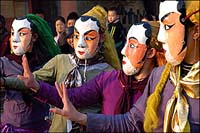
While the Great Wall and Terracotta Warriors in Xi'an are
world-renowned and enjoy top State protection, few seem to realize
that another kind of China's heritage is fading away fast.
"Intangible heritage" includes many traditions and disciplines,
ranging from acrobatics, folk art, craftsmanship, dance,
literature, music and traditional festivals, to medicine and
operas.
"The need for preservation of our intangible heritage is more
pressing than for tangible heritage. Some living traditions can
vanish in only a few years during the rapid modernization and
globalization process," said Su Donghai, a researcher with the
National Museum of China.
Now the Ministry of Culture has unveiled a list of 501 such
heritages online, so as to solicit public views about China's most
important living cultural heritage.
"Both Chinese and foreigners can email (whbsts111@sina.com) or
call us (86-10-6555-2033) in Chinese or English to say what has
been missed off the list, what should be deleted and what should be
highlighted," said Zhang Xin, an official with the ministry's
social culture department.
The list can be found from today until the end of this month at
the ministry's official website:
http://www.ccnt.gov.cn/gsjpd/shwh/.
"Funding will be provided by the ministry to conservation
efforts based on the heritage's importance and need for
protection," said Zhang.
Currently, the thousand-year-old "Legend of White Snake" a love
story of a serpent-turned-beauty and a young scholar is on the
list, as well as Mongolian grassland ballads and a 120-chapter
Tibet epic about their heroic tribal chief Gesar.
Eight kinds of kung fu are also listed, including the kung fu of
Shaolin Temple and the swordsmanship of Taoists in Central
China.
Field hockey, which the Daur in northern China have played since
ancient times in their own way, is also on the list.
(China Daily January 5, 2006)

